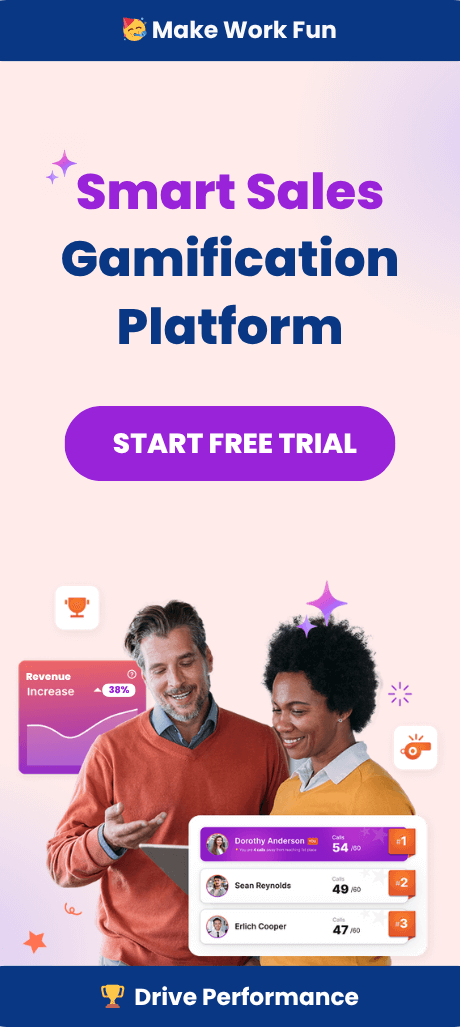A well-designed sales strategy helps sales teams improve their productivity, creativity, innovation, motivation, and problem-solving skills. It gives them a sense of direction and self-confidence. But, traditional sales motivation techniques can be outdated and may not effectively engage today’s workforce.
These conventional methods often don’t accommodate the diverse working styles of sales professionals. They also don’t align with the dynamic nature of sales opportunities. Sales teams need relevant, engaging activities and feedback to stay motivated and achieve better results. Gamification can be a new and practical tool in sales, incorporating achievement badges to recognize achievements and incentivize social learning and engagement.
By implementing game elements, sales managers can increase engagement. In fact, a good gamification strategy can do more than just add game elements to work. It can boost sales motivation, optimize performance, and reduce employee burnout.
It can also introduce objectives that give salespeople a feeling of purpose. Here is the main reason gamification badges work for promoting sales motivation, including some examples that can make implementing gamification a useful tool in a sales environment.
Introduction to Sales Gamification
Sales gamification is the process of integrating game elements and mechanics into sales activities to enhance engagement and motivation. By incorporating game elements like points, badges, and leaderboards, sales managers can create a more immersive and interactive work environment. This approach transforms traditional sales processes into a more enjoyable and competitive experience, encouraging salespeople to participate actively and stay motivated.
In sales, gamification can help address various working styles and provide immediate feedback, making the sales process more dynamic. It leverages the motivational power of games to foster a sense of achievement and progress, which can significantly boost sales motivation and engagement.
What is Gamification in Sales?
Gamification means using game attributes in non-game contexts. Sales managers can add game design elements to the sales environment, similar to how educators incorporate game elements to enhance learner motivation and engagement. This will require salespeople to earn digital badges or gain points for showcasing their achievements or skills.
Gamification techniques can be an alternative to the standard commission-based incentive system. These gamification badges can serve as a visual indicator of the salesperson’s progress, enhancing both extrinsic and intrinsic motivation. It can help improve sales teams’ motivation, personal growth, and involvement.
The goal of these reward systems is to get increased engagement, promote active interest, and offer more challenging opportunities that stimulate the mind.
Gamification Elements vs. Traditional Sales Incentives
Gamification and traditional sales incentives are similar in that both options boost sales motivation and engagement. But they use different elements. Both options can be used to enhance the sales environment.
Gamification uses game elements such as digital badges, a gamification leaderboard, and a points system. It then adds them to standard sales activities. These game elements help engage and motivate sales teams and encourage students to improve their performance through challenges and rewards.
For example, the highest-performing salesperson receives a “Top Closer” award after collecting gamification badges from smaller tasks. The gamification elements give a boost to competition, achievement, and confidence.
Traditional sales incentives involve creating goals where sales principles and characteristics are a natural part of the sales activities. These can include bonuses, trips, or other rewards for hitting sales targets.
For example, a salesperson in a high-stakes environment might be motivated by quarterly bonuses or recognition at a sales event. The incentive-based setting increases drive and ambition.
Why is Gamification Good for Sales?
Gamification is slowly becoming more popular in sales. It can help sales teams better understand their goals and improve attendance, engagement, and overall performance. Gamification elements have a lot to offer.
The benefits of using gamification badges to enhance the sales experience can include the following:
- Friendly competition to motivate salespeople.
- A chance to address different working styles in one approach.
- The ability for sales teams to self-direct their progress.
- Better group problem-solving skills for collecting harder digital badges.
- Improving innovation and creativity for the highest-performing salespeople.
Many companies use gamification to achieve success in sales performance. Gamification not only enhances engagement but also significantly boosts learner motivation, leading to better educational outcomes. Gamification features, such as gamification badges, can be added to CRM systems. Such rewards can increase active participation and concentration.
Acquiring badges motivates salespeople and promotes fun in the workplace. When managers incorporate gamification badges, they create a more immersive work process. Sales teams can have more fun with their targets and goals.
The Role of Digital Badges in Sales
Digital badges are a powerful gamification element used to recognize and reward salespeople’s achievements. These digital tokens are earned by completing specific tasks or reaching certain milestones, serving as a visual representation of a salesperson’s skills and accomplishments. Digital badges can be displayed on company intranets, social media platforms, or personal portfolios, allowing salespeople to showcase their achievements to a broader audience.
Beyond recognition, digital badges also play a crucial role in tracking salespeople’s progress and providing feedback on their performance. By earning these badges, learners acquire knowledge that positively influences their attitudes and behaviors, making the sales objectives clear and attainable. By earning and displaying these badges, salespeople can build a sense of pride and motivation, driving them to continue their journey towards success.
Creating Effective Gamification Strategies
Creating an effective gamification strategy starts with understanding your target audience and their motivations. It’s crucial to align your gamification efforts with the organization’s goals and objectives to ensure that the strategy supports overall business aims. A well-designed gamification strategy should include clear learning objectives, engaging game elements, and a robust reward system.
Educators can incorporate game elements such as digital badges, points, and leaderboards to create a gamified learning environment that is both motivating and enjoyable. These elements should be flexible and adaptable to accommodate different learning styles and preferences, ensuring that all team members can benefit from the gamified approach.
Continuous monitoring and evaluation of the gamification strategy are essential. By regularly assessing the effectiveness of the strategy and making necessary adjustments, you can ensure that it remains engaging and aligned with your learning objectives. This ongoing process helps maintain the relevance and impact of your gamification efforts.
Implementing Gamification in Sales
Implementing gamification in sales can significantly boost performance and motivation among sales teams. By incorporating gamification elements such as badges, rewards, and leaderboards, sales managers can create a sense of friendly competition that encourages team members to work harder and achieve better results.
Gamification can also be used to track sales performance, identify areas for improvement, and provide feedback to sales teams. This approach not only makes the sales process more engaging but also helps managers pinpoint specific areas where additional support or training may be needed.
Integrating gamification with existing sales training programs can make these programs more engaging and effective. Sales teams can be recognized and rewarded for their achievements through social media platforms, creating a sense of pride and accomplishment that further motivates them to excel.
Gamification and Motivation for Sales Teams
It can be challenging to motivate sales teams, especially with distractions such as social media, personal commitments, and other workplace activities. Want to know how gamification badges encourage salespeople to succeed?
Salespeople are driven by reward. Gamification allows them to receive rewards through digital badges, medals, or basic emblems. Since gamification uses the motivational power of video games for real-world applications, it can be a valuable strategy for motivating sales teams.
Gamification creates curiosity. It uses different concepts than traditional motivation techniques and makes salespeople solve real-life problems. Therefore, sales teams are more likely to stay focused on their goals.
According to research, gamification is a vital tool for creating sustainable and high-performing sales teams, mainly through performance and motivation improvement. Managers can motivate and stimulate interest in salespeople through gamified experiences when incorporating game elements.
Managers can use gamification badges to boost motivation and excitement when sales teams get distracted. This can increase attention span.
How Effective is Gamification in Motivating Sales Teams?
Gamification has proven to be an effective tool for improving sales performance and motivating sales teams. When managers integrate gamification elements, such as badges and leaderboards, into their sales strategies, they can significantly boost student motivation and enhance the sales team’s engagement and productivity. As highlighted in this article on Forbes, sales directors have found that gamification not only drives performance but also creates a more dynamic and competitive environment that can lead to higher satisfaction and better results.
Digital badges, in particular, serve as powerful motivators, encouraging salespeople to work harder and achieve their goals. These badges act as visible markers of success, driving both individual and team performance by fostering a sense of accomplishment and healthy competition.
However, it’s essential to recognize that gamification does not impact all personality types in the same way. For instance, some studies have found that introverted salespeople might respond differently to gamification than their extroverted counterparts, logging more badges and points. This suggests that while gamification can be broadly effective, its impact may vary based on individual personality traits and the specific dynamics of the sales environment.
For sales directors, the key lies in tailoring gamification strategies to meet the diverse needs of their teams, ensuring that every member feels motivated and engaged.
Measuring Success in Gamification
Measuring the success of a gamification strategy is crucial to understanding its effectiveness. Establishing key performance indicators (KPIs) such as engagement, motivation, and learning outcomes can help track the success of the strategy. Data analytics can be used to monitor learner behavior, identify areas for improvement, and provide insights into the effectiveness of the gamification strategy.
Surveys and feedback forms can gather qualitative data on the learner experience, helping to identify areas for improvement. Gamification metrics such as badge completion rates and leaderboard rankings can also be used to measure success.
It’s essential to continuously evaluate and adjust the gamification strategy based on the data and feedback collected. This ongoing process ensures that the strategy remains relevant and effective in motivating and engaging learners.
Gamification Elements for Engagement
Several gamification elements can be employed to increase engagement and encourage students, as well as motivate sales teams. These elements include:
- Points: Awarding points for completing tasks or achieving milestones can create a sense of accomplishment and progress.
- Badges: Digital badges serve as rewards for achieving specific goals or completing tasks, providing visual recognition of salespeople’s efforts.
- Leaderboards: Displaying salespeople’s progress and ranking them against their peers can foster healthy competition and motivate them to improve their performance.
- Rewards: Offering tangible rewards for achieving specific goals or completing tasks can provide additional motivation for sales teams.
- Challenges: Creating challenges or quests that salespeople must complete to earn rewards or badges can make the work process more engaging and interactive.
These gamification elements can be used individually or in combination to create a more dynamic and engaging sales environment. By incorporating these elements, sales managers can make work more enjoyable and motivating for their teams.
Best Practices for Gamification
To ensure the success of your gamification efforts, it’s important to follow best practices. Gamification should support learning objectives, not replace them. Using gamification elements such as digital badges and leaderboards can reinforce learning and motivate learners.
Gamification strategies should be flexible and adaptable to accommodate different learning styles and preferences. Combining gamification with traditional teaching methods can create a comprehensive learning experience that is both engaging and effective.
Fairness, transparency, and inclusivity are key to avoiding negative consequences. Gamification strategies should be continuously evaluated and adjusted to ensure they remain effective and engaging. By following these best practices, you can create a gamified learning environment that motivates and inspires learners to achieve their goals.
What is an Example of Gamification in Sales?
To gamify the sales environment, managers would need to use innovative concepts. Gamification needs to award salespeople by the level of commitment. That means using:
- Basic digital badges: Digital badges can take on a simple form, such as an emblem that salespeople get for completing simpler tasks. For example, “Close 10 deals this month.”
- Achievements: Salespeople can collect such rewards when they complete multiple steps, such as collecting ten digital badges.
- Achievement badges: These badges can incentivize social learning and engagement by recognizing milestones and participation in social activities, fostering a sense of accomplishment and community involvement.
- Awards: These rewards should be a one-time opportunity. For instance, salespeople must finish an entire sales module to get awards. This can be a great way of motivating them to achieve success.
But, gamification varies based on the sales environment and the different teams managers work with.



